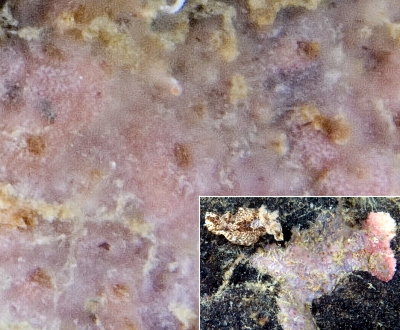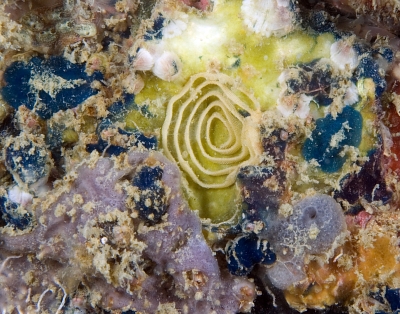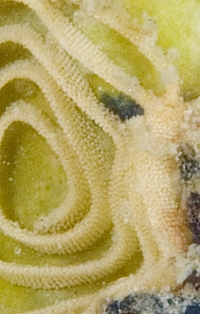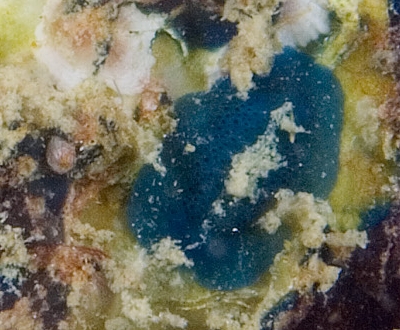Re: Chromodoris mandapamensis from Thailand
August 15, 2008
From: Lawrence Neal

Concerning message #21788:
Hi Bill,
I attached a picture of the pink sponge which could be the food of the C. mandapamensis, as you requested. Not sure how sharp it is as I was only interested in focussing on the slug (that's what you get from an amateur naturalist). Incidentally, the black background is a rubber tyre which forms part of the jetty structure.
Locality: Saphan Tawaen, Koh Larn, Pattaya, 8 metres, Chonburi, Thailand, Gulf of Thailand, South China Sea, 10 August 2008, Jetty. Length: 25 mm. Photographer: Lawrence Neal.
I also attached a picture of an egg ribbon that was about 6 inches away from the animal (diameter of the ribbon was approx. 20 mm). I know this is probably too circumstantial to draw any firm conclusions. However, it's worth noting that this dive site has very few Nudibranchs (but lots of flatworms). We have only seen 2 species over several dives at the site - the C. mandapamensis and a couple of Risbecia tryoni, which are in a different size class. So I think there's a strong possibility that the egg ribbon came from this animal. Anyway, I'll try to revisit the site soon and see if I can come up with some more pictures.
Best regards,
Lawrence
lorenzo_n@yahoo.com



Dear Lawrence,
Thanks for these photos. When I saw your first message I thought the sponge could have been an aplysillid, which is a sponge family which many species of Chromodoris feed on. However after looking at these photos - and the 'egg photo' has a big colony of the pink sponge as well - I am pretty sure it is a sponge with siliceous spicules and most unlikely to be the food of a Chromodoris.
Your egg ribbon photo is quite interesting and contains a nudibranch you hadn't noticed: if you look to the right of the egg ribbon there is a blue object which I have enlarged in the photo alongside my comments. It is the blue form of Doriopsis granulosa and I am pretty sure the eggs belong to it, and the yellow sponge [?Prianos sp.] is its food. As I discuss on the species' Fact Sheet there is a second species, Doriopsis pecten, which is also dark blue which feeds on a dark blue sponge [Terpios sp]. Identifying the two species can be quite difficult because D. granulosa ranges in colour from yellow, to green and the same dark blue as D. pecten. As both food sponges seem to be found together, finding a blue Doriopsis next to a blue sponge does not necessarily mean it must be D. pecten [see message #9351]. Looking carefully at your 'egg ribbon' photo there are quite a few blue objects present but most I cannot identify as sponge or dorid, except for the one on the right of the egg ribbon and probably the one at the upper left. All the others could well be sponge colonies. The reason I suspect the dorid is D. granulosa, is that we know its egg ribbon is the shape and colour of the one in your photo. The egg ribbon of D. pecten is smaller, white, and has a ruffled edge [message #9368]
Best wishes,
Bill Rudman
Related messages
-
Re: Chromodoris mandapamensis from Thailand
From: Lawrence Neal, August 18, 2008 -
Chromodoris mandapamensis from Thailand
From: Lawrence Neal, August 14, 2008 -
Re: Chromodoris striatella with some spots
From: Jean-François Hervé, July 25, 2008 -
Chromodoris mandapamensis from Nhatrang, Vietnam
From: Hua Thai Tuyen, July 4, 2008 -
Chromodoris mandapamensis feeding ?
From: Colin Ogden, February 15, 2007 -
Re: Chromodoris mandapamensis feeding
From: Colin Ogden, March 8, 2006 -
Chromodoris mandapamensis feeding
From: Colin Ogden, March 7, 2006 -
Chromodoris mandapamensis in aquarium sump
From: Chris King, January 26, 2006 -
Re: Chromodoris mandapamensis feeding?
From: Colin Ogden, October 6, 2005 -
Unidentified Chromodoris from South Africa
From: Colin Ogden, October 5, 2005 -
Chromodoris mandapamensis? from Thailand
From: Nararongpon Sittithaweepat, September 27, 2005 -
Chromodoris mandapamensis from Myanmar
From: Mary Jane Adams, May 14, 2003 -
Chromodoris mandapamensis from India
From: Ángel Valdés, July 25, 2000
